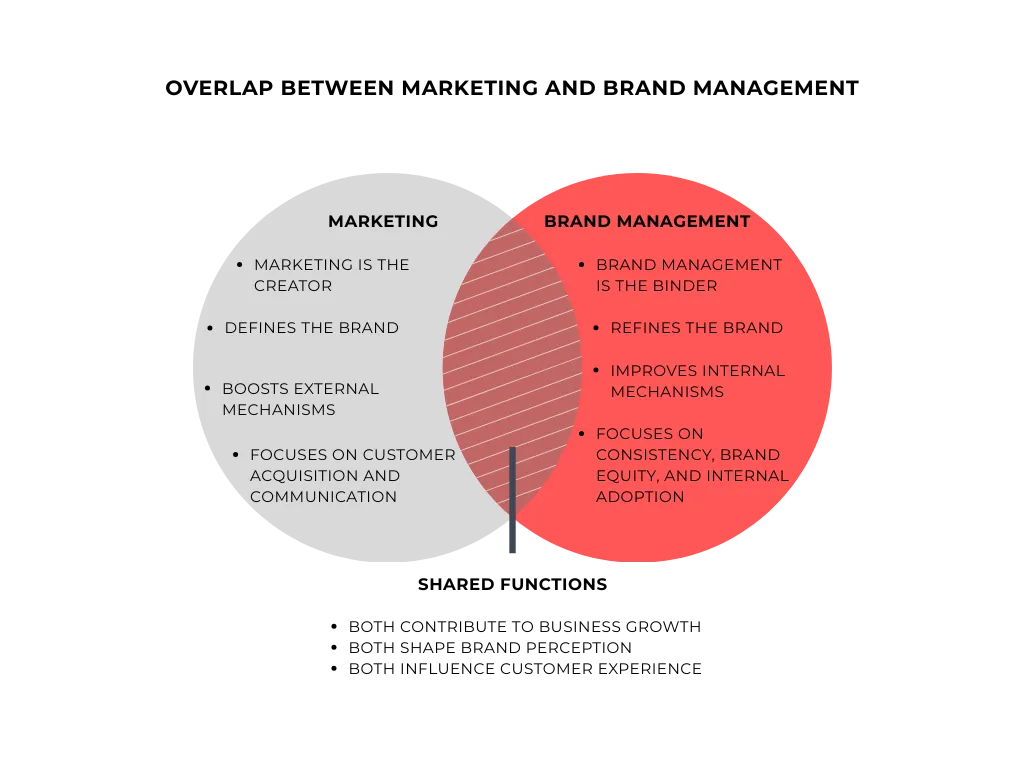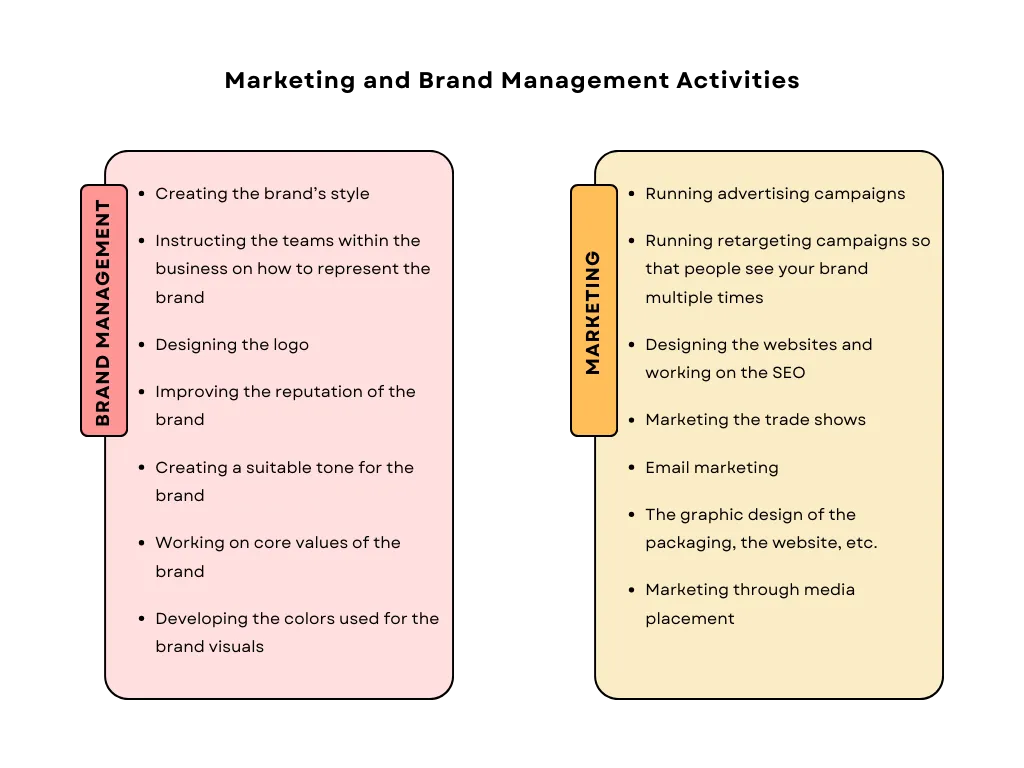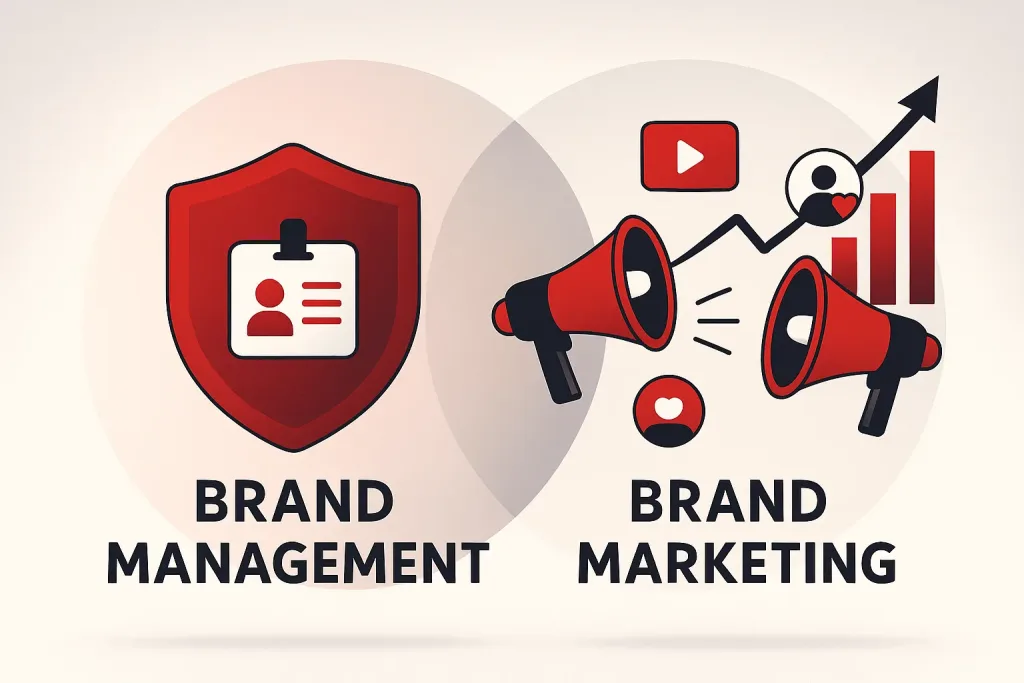Brand management and brand marketing are two terms which are often used interchangeably in the business literature. However, these concepts are two completely different things with very thin borders between them. These two concepts are so intertwined with each other that it is sometimes hard to discern them from one another. Nevertheless, as a business owner, you must know the differences. In broad terms, brand management revolves around the brand itself, its identity, and its image whereas brand marketing involves activities that promote the brand and engage customers. Both overlap and differ at different levels with one single goal: to create a successful and flourishing business. This blog will define each one and will distinguish the differences. Finally, you will realize that both types of management must go hand in hand in running a business.
What is Marketing Management?
In general, marketing is the process of targeting a sector of the population and engaging them with your company’s product. Its final goal is to persuade consumers to buy your product through different techniques and strategies. Marketing departments usually exploit different strategies to this end and their primary goal is to find a way to communicate the brand’s message to the potential customers. Marketers are usually involved with researching the market and analyzing customers, trying to find the consumers’ key interests in order to keep them connected with the brand. Each brand has a message to convey to customers and it is the marketing’s responsibility to successfully communicate this message to them. In short, marketing management involves successfully executing strategies to create the brand image, target potential customers, channel their interests towards your product, and finally persuading them to buy it. Marketing departments also use various innovative techniques to grab and keep customers’ attention.
What is Brand Management?
As the name suggests, brand management is the continuous and constant effort put into maintaining a consistent brand identity. In other words, brand management must make sure that all the content, the brand messages sent to customers, and all the products are in line with what you are trying to communicate. Brand management revolves around maintaining that single message you are trying to communicate with your customers and keeping it consistent. Your business must send one single message to the customers, which in turn will strengthen the brand identity, and this is the brand management’s job to do.
To put it differently, brand management acts as the backbone for the process of creating brand equity. This means that brand management must ensure the whole business and its departments work in harmony to effectively build a healthy relationship with customers. It is the bond that glues all parts of a business – from the management level to the final physical product – into one whole body acting together towards the goals of the business.
Key Differences between Marketing and Brand Management
As you might have realized, marketing and brand management both overlap in several areas but they are also different. The following list has grouped the differences in three different categories:
-
Marketing is the creator and brand management is the binder
In the early stages of a business, it is the marketing team that take control of all developmental stages from brand recognition to communicating directly to the customers. Alternatively, it is possible to say that marketing is responsible for attracting the consumers’ attention whereas brand management works to keep that attention. As the business grows and messages spread across many different platforms, a brand management team is usually assembled to unify all these messages around one single brand identity, which in turn will create brand equity.
-
Marketing defines the brand and brand management refines it
Marketers are the first people to take control of your brand development and lay the foundation during the early stages; however, when the brand grows, the marketing department can no longer keep everything bound together, and therefore, it is time for another team to emerge and keep everything consistent. Brand managers are the ones who will enter to deal with numerous newly-emerged issues such as the following:
- what the brand image will look like: the logos and all the visuals related to the brand
- what the brand will sound like: the tone and voice of the brand
- what the brand symbolizes: the values your brand is associated with, its goals, and what it stands for in the minds of the customers
-
Marketing boosts the external mechanisms of the brand while brand management improves the internal ones
The customers’ first experience with your product and brand is always through your marketing. It is the marketing team that builds your relationship with your customers, and so this is what the marketing does outside of your brand and at the sales level; It is the marketing’s job to sell your product, after all. However, it is the brand management’s job to build an internal engagement inside the business through creating brand equity. Brand managers encourage brand adoption within the business and across the teams and the various departments. They also decide on the creation and organization of brand assets. It is brand management’s responsibility to communicate any updates to the brand with the teams across the business, as well.

Goals of Marketing Management
The major goal of marketing is to increase awareness of your brand and build a reputation for it. Marketers constantly try to study customers’ interests in order to establish a rapport with them. The marketing goals can be defined in various ways but the list could be short-handed as the following:
- Creating and developing an image for the brand. Marketers do this by creating visuals such as symbols, logos, colors, packaging, etc.
- Improving the recognition of the brand and facilitating its recall by customers
- Creating brand loyalty among the target customers
- Creating and increasing brand ambassadors, that is, customers who would recommend your brand to others
- Increasing engagement with the brand through techniques that encourage the customers to interact with the brand
Goals of Brand Management
It is the brand management’s responsibility to keep all the marketing efforts consistent across all aspects of the brand. Therefore, brand managers employ techniques and strategies to boost the perceived value of your product and services. On this path, brand managers have several goals to achieve:
- Establishing an emotional relationship with customers: To this end, brand managers might create fascinating backstories that customers can relate to
- Making the brand stand out: managing to create that one identity that differentiates your product from others in the market is the ultimate goal of brand managers.
- Fostering trust and reliability: customers always go for the brand they trust and brand managers must always keep this in mind and try to achieve it through hard effort.
Marketing and Brand Management Activities
Brand management includes activities such as:
- creating the brand’s style
- instructing the teams within the business on how to represent the brand
- designing the logo
- improving the reputation of the brand
- creating a suitable tone for the brand
- working on core values of the brand
- developing the colors used for the brand visuals
on the other hand, marketing includes activities such as:
- running advertising campaigns
- running retargeting campaigns so that people see your brand multiple times
- designing the websites and working on the SEO
- marketing the trade shows
- email marketing
- the graphic design of the packaging, the website, etc.
- marketing through media placement

How Marketing and Brand Management Work Together
As it can be inferred from the information given, marketing and brand management are not exactly two different things but two sides of the same coin working towards the goals of a business. A powerful brand management can help marketing achieve its goals and vice versa. For instance, A good brand management will allow marketing to create better advertising campaigns and will also help the departments cooperate more smoothly. However, as much as it is important that the marketing team and the branding team work hand in hand, it must be noted that these teams should not be merged. A powerful branding management will free the marketing from other tasks and will allow them to focus on their main goal, that is, marketing your product and selling it in the market.
Conclusion
Both brand management and marketing are of vital importance to a business. Therefore, understanding the differences and the overlaps is crucial in achieving the long-term goals of a business. They both complement each other and simultaneously work together to create a flourishing business. One works internally and the other externally, one creates and the other continues, one defines and the other refines, one is more long-term while the other is more short-term, but whatever the differences, they both follow one single goal: to boost sales of the business.


